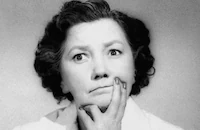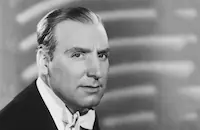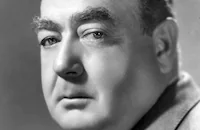There Goes My Heart

Brief Synopsis
Cast & Crew
Norman Z. Mcleod
Fredric March
Virginia Bruce
Patsy Kelly
Alan Mowbray
Nancy Carroll
Film Details
Technical Specs

Synopsis
Because heiress Joan Butterfield can't convince her grandfather to let her do what normal girls her age do, she decides to sneak away from their yacht and go off on her own in New York City. Reporter Bill Spencer arrives at the yacht just before she leaves, hoping to get a rare photograph of her for his editor, Mr. Stevens, but he is only able to get a glimpse of her. Bill is determined to get his story on Joan and convinces Stevens to let him continue his pursuit. While other papers are trying to find the missing heiress, Bill decides to do a story contrasting her life with that of an ordinary salegirl in her grandfather's department store. Meanwhile, Joan meets good-hearted Peggy O'Brien in an automat and is able to get herself a free lunch when Peggy's is stolen and the manager refuses to replace it until the well-dressed Joan says that hers was stolen as well. The girls become friends and Peggy offers to let Joan stay with her, thinking that she is down-on-her-luck. She also promises to get Joan a job in Butterfield's department store, where Peggy works. Because Joan does not want anyone to know who she is, she assumes the name of Joan Baker. She enjoys her new life, even though adapting to everyday situations like cooking dinner prove challenging. When Bill comes into the store to do his feature, he recognizes Joan and, hoping to get a hot story, he pursues her. After first trying to avoid Bill, Joan soon agrees to go out with him, but inadvertently manages to squelch every attempt he makes to photograph her. As he gets to know Joan for the down-to-earth person she really is, Bill begins to fall in love with her. One day, when Joan accidentally leaves her watch in the women's restroom at Butterfield's, Dorothy Moore, a jealous co-worker, sees the inscription, "To Joan Butterfield--from Gramps" and realizes Joan's true identity. While Dorothy goes to Gramps, Peggy agrees to help Joan, even though she can't understand why Joan prefers the life of an ordinary salesgirl to her own. Not knowing that Bill has secretly been working on a story about Joan, Peggy calls him to tell him what has happened and he takes Joan to his island cabin just twenty-five miles from New York. That night, at his cabin, they realize that they are in love and Bill decides to stop Stevens from printing the story about Joan. The next morning, he secretly goes to New York to get some groceries and a marriage license and tears his story up into little pieces. As soon as Bill leaves, however, Stevens calls the entire newsroom staff in to glue the story back together, and before Bill can return to the island, his "exclusive" on a secret romance with Joan is headline news. Gramps then calls the paper and learns from Bill's pal, Flash Fisher, where he has taken Joan. By taking a speed boat, Gramps and his staff arrive at the island before Bill and show Joan the story with Bill's byline. When Bill arrives, Joan is so hurt and angry that she leaves without allowing him to explain. Some time later, Peggy and her chiropractor boyfriend, Pennypepper E. Pennypepper, decide that the best way to get the stubborn pair back together is to send each a telegram signed by the other, asking to meet at the island cabin. When they meet, they are at first reluctant to forgive and forget, but soon realize they are in love when a thunderclap causes the frightened Joan to rush into Bill's arms. Finally, a local minister who was sent to the island by Peggy and Penny enters the cabin at the right moment with his prayer book opened to the wedding ceremony.

Director

Norman Z. Mcleod
Cast

Fredric March

Virginia Bruce

Patsy Kelly

Alan Mowbray
Nancy Carroll

Eugene Pallette

Claude Gillingwater
Arthur Lake

Etienne Girardot

Robert Armstrong

Irving Bacon

Irving Pichel
Sid Saylor

J. Farrell Macdonald

Harry Langdon

Marjorie Main
Mary Field

Greta Granstedt

Moroni Olsen
Walter Ridge

William Davidson
Charles Waldron
Joseph King
Adia Kuznetzoff
Pat Gleason
Kenneth Harlan
Pat Lane
Nat Nealon
Joe Mcquinn
George Ovey
Bill Clark
Jack Egan
Jerry Colonna
Bill Irving
Billy Engle
Bobby Barber
Ed Phillips
Ann Luther
Rosanne Coyle
Billy Wayne
Eddie Dunn
Tommy Mack
George Chandler
Matt Mchugh
Sydney Jarvis
Malcolm Waite
Sarah Edwards
Norman Phillips Jr.
Billy Taft
Joe Ploski
Ernie Adams
Harry Lang
Dell Henderson
Lionel Braham
Will Stanton
George Humbert
Marjorie Kane

Lloyd Ingraham
William Worthington
Hal K. Dawson
Duke York
George Burton

Walter Walker

Jinx Falkenberg
Elaine Shepard
Gwen Seager
June Glory
Crew
Milton H. Bren
Norbert Brodine
W. B. Delaplain
Charles D. Hall
Marvin Hatley
Irene
Jack Jevne
Eddie Moran
William Randall
Hal Roach
Roy Seawright
W. L. Stevens
Ed Sullivan
William Terhune

Film Details
Technical Specs

Award Nominations
Best Score
Articles
There Goes My Heart
Best known for comedy shorts with the likes of Harold Lloyd and Laurel and Hardy (his studio was known as the "Lot of Laughs"), Hal Roach had begun making feature films in the 1920s. He made dramas, westerns, and action pictures as well as comedies, which were distributed by MGM. There Goes My Heart was the first Roach film to be distributed by United Artists. An almost carbon copy of It Happened One Night (1934), the film features a runaway heiress going incognito to see how the other half lives, pursued by a reporter who's on to her disguise.
Virginia Bruce was a lesser leading lady of the 1930s and 40s, whose cool glamour better suited her for supporting roles as the other woman than for comedy. Hampered by a predictable and derivative script (the story was by Broadway columnist Ed Sullivan, who in the 1950s hosted a wildly popular television variety show), she and March were not at their best in There Goes My Heart. The outstanding performances in the film are by veteran character actors such as Eugene Palette as March's gravel-voiced editor, Patsy Kelly as the wisecracking shopgirl who takes Bruce under her wing, and Claude Gillingwater as Bruce's overbearing grandfather. The inimitable Marjorie Main has a bit part as a customer, and look for King Kong's Robert Armstrong in a small role as a detective.
The appearance of two former stars in There Goes My Heart is even more intriguing. Harry Langdon had been one of the top silent film comics, in a league with Chaplin, Keaton, and Lloyd. In the mid-1920s, he left Mack Sennett for Warner Bros., where he had control of his own productions. His team included Frank Capra as writer, and later director, but after three very successful films, Langdon decided he could handle all those chores himself, and fired Capra. Langdon's subsequent films were disasters, and Warner Bros. did not renew his contract. In the early 1930s, Roach, who liked to try out over-the-hill stars to see if he could revive their careers, gave him another chance, signing him to do a series, but that, too was a failure. A few years later, during a contract dispute with Stan Laurel, Roach brought Langdon back. Landon's unbilled bit part as a minister in There Goes My Heart stirred interest in him, and the following year, Roach starred Langdon with Oliver Hardy in Zenobia (1939), but Hardy soon returned to his partnership with Laurel. Langdon continued to work sporadically until his death in 1945, always dreaming of a return to the stardom that had long faded.
Another former star, Nancy Carroll, who had teamed memorably with March in Laughter (1930), had a supporting role in There Goes My Heart as Kelly's roommate and fellow shopgirl. Carroll had been one of the biggest stars of the early sound period, but by 1938, her career was faltering. The film did nothing to revive it (Photoplay noted, "Nancy Carroll returns to the screen as another shopgirl, but she does not Come Back."), and she made only one more feature film before retiring from the screen.
The era of screwball comedies was drawing to a close when There Goes My Heart was made, and that, along with the copycat element, led to a lukewarm reception for the film. Photoplay praised Patsy Kelly's performance, and added, "If you are still a devotee of the 'mad, mad fun' school, you will probably enjoy this." Howard Barnes's review in the New York Herald Tribune was equally tepid: "While the plot structure remains familiar and feeble, there is enough incidental nonsense to take your mind off it a good deal of the time. The clowning is random, but it is generally refreshing." Seen today, some of the "incidental nonsense," like Patsy Kelly's sublimely comic attempt to sell a vibrating exercise machine, are reason enough to see the film.
Producer: Milton H. Bren, Hal Roach
Director: Norman Z. McLeod
Screenplay: Jack Jevne, Eddie Moran, Ed Sullivan (story)
Cinematography: Norbert Brodine
Film Editing: William H. Terhune
Art Direction: Charles Hall
Music: Marvin Hatley
Cast: Fredric March (William Z. Spencer), Virginia Bruce (Joan Butterfield), Patsy Kelly (Peggy O'Brien), Alan Mowbray (Penny Pennypepper), Nancy Carroll (Dorothy Moore), Eugene Pallette (Stevens).
BW-84m.
by Margarita Landazuri

There Goes My Heart
Quotes
Trivia
Notes
This film was the first feature release of Hal Roach Studios, Inc. through United Artists. For many years previous to the production of this film, Roach pictures had been released through Metro-Goldwyn-Mayer and Loew's, Inc. According to a news item in the New York Times on October 16, 1938, the Citizen's Chiropractic Committee of the state of New York sued the producers of the film and Alan Mowbray for $100,000 in damages to the profession which resulted from its release. According to the same news item, the New York State Chiropractic Committee, and Dr. Sol Goldsmith of New York were particularly upset that the film implied that it was possible to go to chiropracty school through a correspondence course. Several reviews commented on the fact that Harry Langdon, who was one of the most famous film comedians of the silent era, did not even receive billing for his brief role as a minister. A contemporary news item noted that it was his first film role in four years. The Hollywood Reporter review mentioned that heiress Barbara Hutton, known at the time as the "richest girl in the world," must have been the "inspiration" for the picture. Pedro de Cordoba was identified in a production still from the film, but he does not appear in the released film. Music director Marvin Hatley was nominated for an Academy Award in the Music (Scoring) category for his work on the picture.

Miscellaneous Notes
Released in United States 1938
Released in United States 1938














